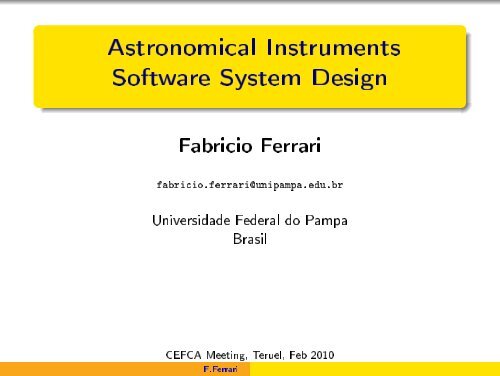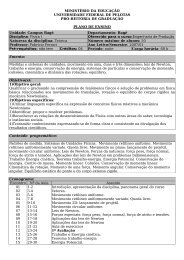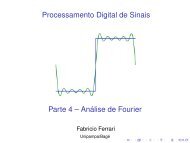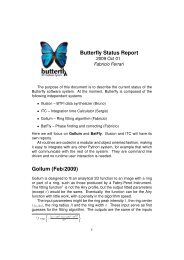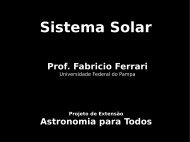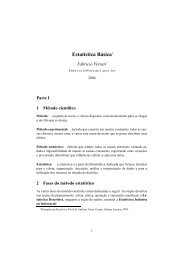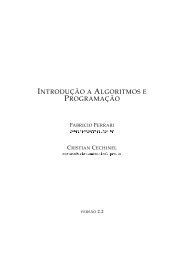Astronomical Instruments Software System Design - Fabricio Ferrari ...
Astronomical Instruments Software System Design - Fabricio Ferrari ...
Astronomical Instruments Software System Design - Fabricio Ferrari ...
Create successful ePaper yourself
Turn your PDF publications into a flip-book with our unique Google optimized e-Paper software.
<strong>Astronomical</strong> <strong>Instruments</strong><br />
<strong>Software</strong> <strong>System</strong> <strong>Design</strong><br />
<strong>Fabricio</strong> <strong>Ferrari</strong><br />
fabricio.ferrari@unipampa.edu.br<br />
Universidade Federal do Pampa<br />
Brasil<br />
CEFCA Meeting, Teruel, Feb 2010<br />
F.<strong>Ferrari</strong>
Facts<br />
Data is beyond astronomers processing capabilities<br />
Cycle observego-homereduceanalyzepublish<br />
not practical<br />
<strong>Instruments</strong> are sub utilized; lots of unused data<br />
Telescopes automatized, data analysis mostly manual<br />
Solving problems: easier in hardware, cheaper in software<br />
F.<strong>Ferrari</strong>
Rationale<br />
Why do we need a software {system|group|meetings}?<br />
∗ Complex instruments ←− complex software<br />
∗ And data not useful without its software:<br />
∗ Thus software is part of instrument<br />
modern instruments = software + hardware<br />
F.<strong>Ferrari</strong>
What do we need?<br />
We need<br />
hi-level<br />
user not aware of hardware details<br />
state-of-art we must trust what we get from software<br />
intelligent<br />
system take decisions by itself<br />
automated<br />
few decisive user interactions<br />
data processing<br />
science out of raw data.<br />
system.<br />
Besides: On-the-y procedures, pipelined, astronomer-friendly<br />
F.<strong>Ferrari</strong>
How to put so many pieces together?<br />
Individual processes known (mostly),<br />
but how to integrate them into One <strong>System</strong>?<br />
Humans: Portuguese, Spanish, French, English, ...<br />
Computers: C/C++, Python, IDL, LabView, ArcView, SML,<br />
VBasic.<br />
F.<strong>Ferrari</strong>
<strong>Software</strong> <strong>System</strong> Guidelines<br />
development,<br />
portability,<br />
integration,<br />
maintenance,<br />
usability<br />
F.<strong>Ferrari</strong>
Modular <strong>Design</strong><br />
discrete, scalable, reusable modules of isolated,<br />
self-contained functional elements;<br />
simple modules with objective tasks<br />
good interface design (what it needs and what it provides)<br />
information hiding (abstraction)<br />
object oriented design<br />
disadvantage is increase in communication<br />
network sockets and hi-level remote objects.<br />
simple examples of modular design:<br />
hardware: computer parts software: IRAF<br />
F.<strong>Ferrari</strong>
Open Source Tools Operating <strong>System</strong>:<br />
Linux<br />
Many avors (distributions):<br />
Debian (servers), Ubuntu (development), Fedora (SOAR).<br />
Tools quality and availability.<br />
∗ my system: 1427 installed packages (8 Gb), 24692 available.<br />
∗ programming languages (C/C++, Java, Perl, Python,<br />
Fortran),<br />
∗ text processors and editors (OpenOce, L A T E X),<br />
∗ scientic and data analysis tools (Scilab, Octave, Maxima,<br />
Gnuplot)<br />
Native multitask, multiuser, networkable system.<br />
Extensively tested on many environments:<br />
desktops, servers, development.<br />
Huge (and growing) scientic community of users and<br />
developers.<br />
F.<strong>Ferrari</strong>
Open Source Tools Programming language:<br />
Python<br />
Object oriented paradigm, imperative, dynamic typed;<br />
Emphasizes programmer productivity, code readability;<br />
Multi-plataform (Linux, Mac, MS-Windows, cell phones,<br />
...)<br />
Large and comprehensive standard library, batteries<br />
included<br />
Powerful and easy to integrate external libraries<br />
PyFITS, NumPy, SciPy, PyRAF, PyRO,<br />
PyLab/Matplotlib.<br />
STSDAS, astLib, AstroLib (IDLs twin), PyMIDAS,<br />
EphemPy, ...<br />
data handling capabilities<br />
high level data types (lists, dictionaries, sets, arrays, ...)<br />
Exceptions: C/C++ for bottlenecks, hardware drivers,<br />
F.<strong>Ferrari</strong>
(1 minute Python Example)<br />
F.<strong>Ferrari</strong>
Open Source Tools Formats<br />
Data: (dependant on le complexity and size):<br />
FITS images and tables<br />
normal or Gzip compressed plain text les<br />
optionally XML for cong and small structured les<br />
Documentation:<br />
L A TEX, OpenOce, PDF, HTML<br />
preference for convertable and web formats<br />
F.<strong>Ferrari</strong>
Open Source Tools Philosophy<br />
Scientic reserch has the paradigm of open source<br />
Focus on human resources, not only on products.<br />
Not cheaper, neither easier,<br />
but works better for longer.<br />
F.<strong>Ferrari</strong>
<strong>System</strong> Availability<br />
Source code available, even if c○<br />
Monthly snapshots (at least), data server or CVS<br />
code freeze versions regularly<br />
Documentation is critical (means availability)<br />
user's manual: what is, who did, what does, how to and<br />
not to use, real examples<br />
programmers manual: program structure, API,<br />
protocols, interfaces, tools, external codes, ...<br />
source code comments: header le and author<br />
name, date, version, comments; classes or functions <br />
descriptions, interface, on relevant code.<br />
Comments are better the farther the author is.<br />
If your program is not well documented, it is useless without<br />
you.<br />
F.<strong>Ferrari</strong>
General Structure<br />
<strong>Software</strong> Point of View<br />
core = control center = command center<br />
F.<strong>Ferrari</strong>
The Command/Control Center<br />
Abstraction layer<br />
between world and<br />
hardware<br />
World communication<br />
no hardware dependent<br />
commands<br />
Hardware<br />
communication<br />
hardware dependent<br />
commands<br />
one software module per<br />
hardware part (Etalon,<br />
iBTF, EMCCD, ...)<br />
F.<strong>Ferrari</strong>
<strong>Software</strong> and Hardware<br />
F.<strong>Ferrari</strong>
The Hardware Drivers<br />
Complete Dummy mode for<br />
no-hardware tests<br />
Results in relevant physical units<br />
calibration curve inside drivers<br />
pulse→degrees,<br />
capacitance→distance, ...<br />
LabView, ArcView, SML ?!<br />
F.<strong>Ferrari</strong>
The BTFI Example<br />
Brazilian Tunable Filter Imager<br />
F.<strong>Ferrari</strong>
BTFI <strong>Software</strong> Structure<br />
F.<strong>Ferrari</strong>
Elements<br />
KFCC Keith-Fernando Control Center<br />
Phase I, II, III, IV<br />
GCC Giseli Control Center<br />
Middleware, Core of the system<br />
<strong>Instruments</strong><br />
Device(LabView), <strong>Software</strong> driver, Hardware<br />
Data Analysis<br />
Corrections, Calibrations, Data science-ready<br />
F.<strong>Ferrari</strong>
KFCC Keith-Fernando Command Center<br />
Phase I: simple elementar (atomic) commands<br />
one-to-one correspondence with GCC set of commands<br />
shutter.open(), ccd.integrate()<br />
Phase II: small set of atomic (molecular) commands<br />
take_image(), make_datacube(), ...<br />
Phase III: high complexity commands<br />
lambda_calibrate(), gap_determination(), ...<br />
Phase IV: Final KFCC for SOAR<br />
LabView'ed, Inspired in SOI, ready for use<br />
F.<strong>Ferrari</strong>
KFCC Phase I<br />
F.<strong>Ferrari</strong>
GCC<br />
Middleware: KFCC <strong>Instruments</strong><br />
bridge between languages, protocols, plataforms<br />
Core of the system<br />
Set of elementar atomic commands only<br />
hi-level to observer software (HLCP),<br />
mid-level to instruments software (MLCP)<br />
Basic error checking<br />
Resource locking (race conditions avoidance)<br />
Conguration variables acessible to all systems<br />
Status GUI with all information (read-only)<br />
F.<strong>Ferrari</strong>
Data Processing<br />
F.<strong>Ferrari</strong>
Waterfal Development Model<br />
F.<strong>Ferrari</strong>
Iterative Incremental Development Model<br />
Hardware drivers Data Processing Command Center GUI<br />
F.<strong>Ferrari</strong>
Scientic Visualization<br />
3Dslicer<br />
VTK - Visualization Toolkit<br />
http://www.slicer.org/<br />
http://public.kitware.com/VTK/index.php<br />
VisIt visualization Tool<br />
https://wci.llnl.gov/codes/visit/home.html<br />
Teem - representing, processing, and visualizing scientic raster<br />
data.<br />
Scientic Computing and Imaging (SCI) Institute<br />
(many OpenSource data visualization tools)<br />
http://teem.sourceforge.net/<br />
http://www.sci.utah.edu/index.html<br />
DISLIN Scientic Plotting <strong>Software</strong><br />
http://www.dislin.de/<br />
F.<strong>Ferrari</strong>
Python Resources<br />
PyRO - Remote Objects<br />
Psyco - otimization<br />
http://pyro.sourceforge.net/<br />
http://psyco.sourceforge.net/<br />
AstroPy - astronomical resources<br />
http://www.astro.washington.edu/owen/AstroPy.html<br />
PyEphem<br />
MatPlotLib<br />
http://rhodesmill.org/pyephem/<br />
http://matplotlib.sourceforge.net/<br />
Interactive Data Analysis in Astronomy with Python (IDL style),<br />
Perry Greeneld and Robert Jedrzejewski<br />
http://www.scipy.org/wikis/topical_software/Tutorial<br />
F.<strong>Ferrari</strong>


